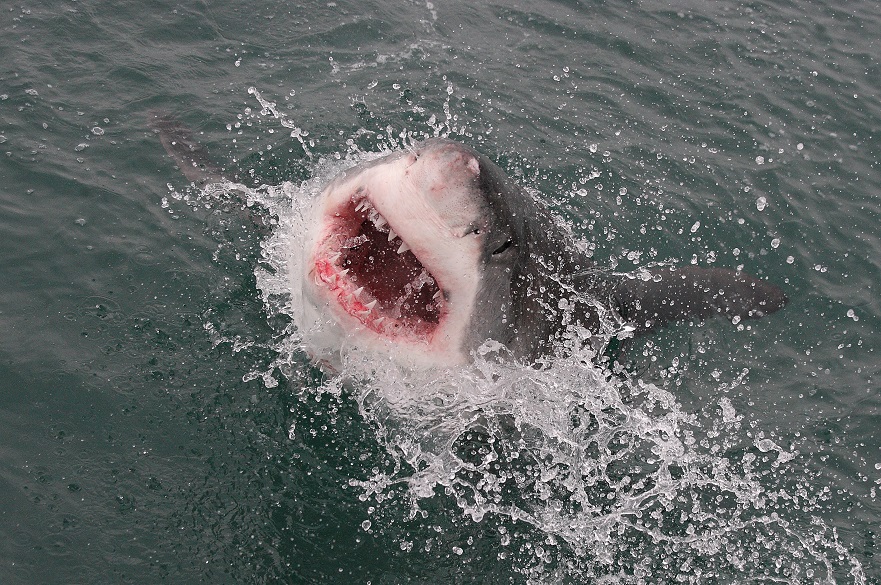Juvenile great white sharks select ‘training grounds’ where they can safely hone their hunting skills, research suggests
Juvenile great white sharks select certain waters as ‘training grounds’ where they can safely learn to hunt larger prey, a new study suggests.
By Dave Rogers | Published on 5 May 2021
Categories: Press office; Research; School of Animal, Rural and Environmental Sciences;

Researchers at Nottingham Trent University investigated the way in the way in which great whites used different habitats during their various life stages.
Working with research and conservation organisation White Shark Africa, the team studied the population of great whites in South Africa’s Mossel Bay.
The bay, which includes sheltered conditions, has an abundance of prey suitable for juvenile sharks – including fish and rays – and marine mammals such as seals and small whales once they begin to develop and increase in size.
The researchers found that from more than 3,000 great white shark sightings over five years, more than four out of five (81%) were classed as juveniles, meaning they were between 1.75m and 3m in length.
No adults were sighted, with the remaining sharks classed as sub-adults and measuring between 3.1m and 3.6m.
Looking at the abundance of great white sharks across the seasons, they were found to be more numerous when water visibility exceeded three meters in depth, which would make for ideal hunting conditions.
More sightings were also made when there was less cloud cover, when it would be easier to spot prey and for the great whites to utilise their countershading more effectively.
The researchers also found that fewer than seven percent (6.9%) of great whites sighted could be identified as male, suggesting that females may also favour these protected bays and coves.
They argue that juvenile sharks are using this bay not only as a nursery ground, but also a training ground to learn to hunt and grow in relatively safe conditions and so as not to compete with larger sharks feeding at other sites.
The greater number of females recorded could suggest the site is being used to avoid mating harassment from males, the team says.
Sea surface temperature was found to be a key indicator of great white shark presence, with cooler temperatures between June and August predicting a higher abundance of sharks. While males maintained a low abundance throughout the year, female numbers differed seasonally and were most numerous during the winter season.
Great whites are classified as ‘vulnerable’ by the International Union for the Conservation of Nature (IUCN) – just one step away from being listed as ‘endangered’.
Although it is widely agreed that numbers are decreasing, very little is still known about great white shark populations.
The study was carried out using data from boat skipper logbooks and citizen science research data obtained via a cage diving vessel.
“Very little is known about great white populations and how these sharks use different habitats during their life stages,” said Dr Nicholas Ray, a researcher in Nottingham Trent University’s School of Animal, Rural and Environmental Sciences.
He said: “We know that these sharks have capacity for social learning, and the greater numbers of juveniles sighted throughout our study suggests that younger great whites have adopted this bay as a crucial nursery and potential training ground where they can learn to hunt in relative safety.
“It appears the sheltered conditions and abundance of food are ideal and serve to increase their growth and development and help them to avoid predation, competition and harassment from larger sharks. It would appear they’re using these waters to prepare for adulthood.
“Research into these enigmatic creatures is crucial to better understand their needs and ultimate survival. Our findings could help protect specific habitats that these sharks utilise at different stages of their life. It might also bring about further legislation to support a vulnerable species at risk of extinction.”
Dr Louise Gentle, a wildlife conservation expert at Nottingham Trent University, said: “Citizen science, where members of the public record data, is important in helping conservationists to monitor wildlife. It adds vital information that can be used to create effective management plans to help save species from extinction.”
Craig Ferreira, CEO of White Shark Africa, said: “This paper overwhelmingly supports my opinion that the southern African white shark population is far larger than previously projected. It also clearly shows that a new study on population is necessary.”
The study is published in the journal Environmental Biology of Fishes.
Notes for Editors
Press enquiries please contact Dave Rogers, Public Relations Manager, on telephone +44 (0)115 848 8782, or via email.
Nottingham Trent University (NTU) was named University of the Year 2019 in the Guardian University Awards. The award was based on performance and improvement in the Guardian University Guide, retention of students from low-participation areas and attainment of BME students. NTU was also the Times Higher Education University of the Year 2017, and The Times and Sunday Times Modern University of the Year 2018. These awards recognise NTU for its high levels of student satisfaction, its quality of teaching, its engagement with employers, and its overall student experience.
The university has been rated Gold in the Government’s Teaching Excellence Framework – the highest ranking available. It is one of the largest UK universities. With nearly 32,000 students and more than 4,000 staff located across four campuses, the University contributes £900m to the UK economy every year. With an international student population of more than 3,000 from around 100 countries, the University prides itself on its global outlook. The university is passionate about creating opportunities and its extensive outreach programme is designed to enable NTU to be a vehicle for social mobility. NTU is among the UK’s top five recruiters of students from disadvantaged backgrounds and was awarded University of the Year in the UK Social Mobility Awards 2019.